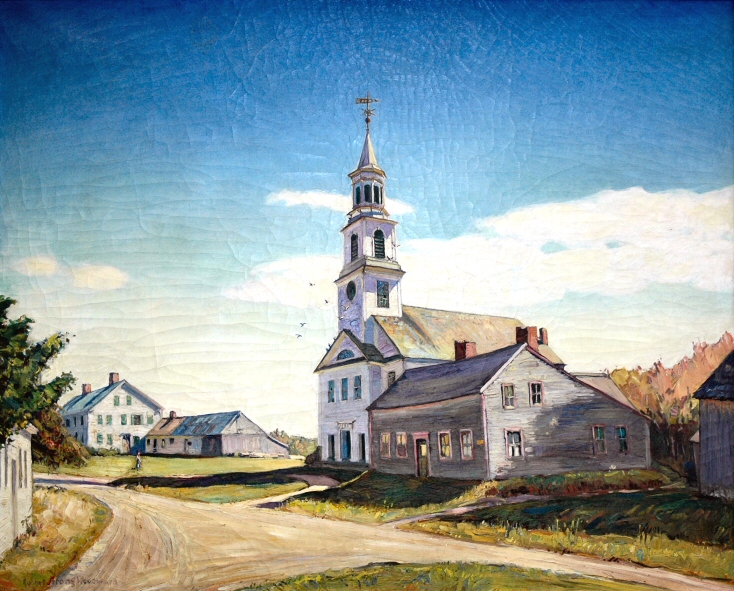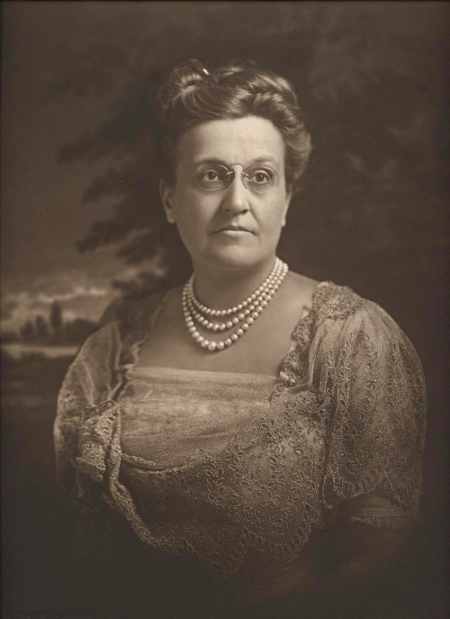The Francis and Mabel Garvan Commission
INTRODUCTION: Great Intentions
In October of 1937, the painting, Enduring New England, hung along with four other paintings at the Macbeth Galleries in New York City (NYC). Enduring New England was there waiting for lawyer, philanthropist, and arts & crafts collector, Francis P. Garvan to view in hopes of being purchased as part of the Mabel B. Garvan (his wife) Collection to be given to the Yale University Art Museum. Mr. Garvan makes it there just before the showing ends on the 18th of the month. He buys the painting and it is immediately sent to Yale where it remains to this day. Mr. Garvan would unfortunately die unexpectedly just twenty days later apparently leaving Woodward on the hook for a number of other, similarly themed "church paintings" reportedly ordered by Mr. Garvan to be included in the collection.
Apparently, as mentioned in Woodward's painting diary remarks for Enduring New England, the other completed church paintings did not make it to Macbeth in time for Mr. Garvan to see them and so Enduring New England is the ONLY painting to make the collection. After Mr. Garvan's untimely death, Mrs. Garvan refused to honor the contract between Woodward and Mr. Garvan for a series of paintings described by Woodward in his remarks for The Potter Homestead, to be a study, "showing the growth of architecture (largely churches but also of fine dwellings) in America."
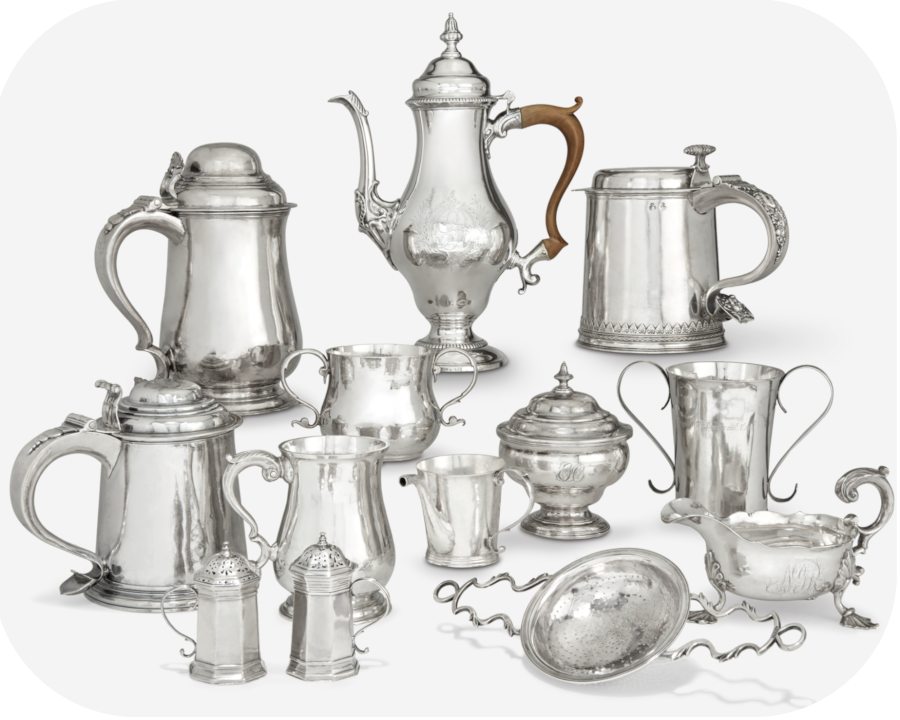
 18th Century American Decorative Serveware
18th Century American Decorative Serveware
The oddity to this so-called commission is that it does not meet or even seems well suited to the initial intent of the collection itself. The Garvans had amassed over 20,000 pieces and artifacts of early American furniture, Folk and Decorative Arts, along with one of the finest collection of handcrafted silver-smithed serveware and tableware (from pitchers and beakers to spoons and punch ladles) by renown American silversmiths. The collection also includes jewelry and indigenous American crafts. We could not find any mention of artwork, specifically paintings. This fact alone indicates perhaps why Mrs. Garvan did not honor the agreement. It was not her doing. This was something specifically carried out by Mr. Garvan.
This essay will explore the origins of this contract between Mr. Garvan and Woodward and put it into context using all the information we have from Woodward's records:
 to laying out a timeline...
to laying out a timeline...
 revealing the paintings that never made it to oil as well as...
revealing the paintings that never made it to oil as well as...
 what became of the paintings he did finish, and
what became of the paintings he did finish, and
 what it tells us about what Woodward considered his brand
what it tells us about what Woodward considered his brand
While we will not be able to answer all of the questions we will raise, asking the questions themselves will prove helpful for context.
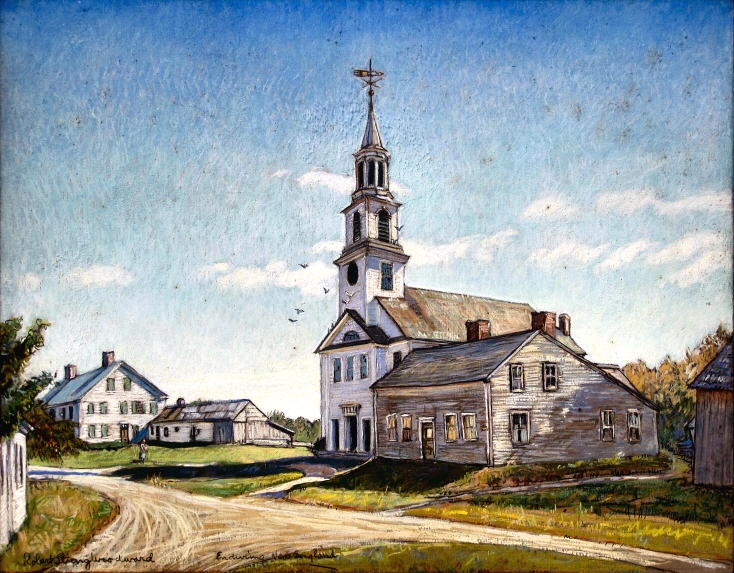
 Enduring New England, chalk, 1930
Enduring New England, chalk, 1930
Enlarging the image will show only the lower third
of the drawing to emphasize the village's dirt road
AN INNOCENT BEGINNING: The Village Center
It is 1930 and Woodward has a new 1929 Nash 421 5-passenger phaeton. He has been traveling to Heath for at least five years and would cross over from time to time to Halifax were he discovers his beloved abandoned farm, the Halifax House, in West Halifax just over the stateline. Marlboro, Vermont is the town just north of Halifax. If you look at the Vermont state locator map we prepared for this page (below right), the four squares on the southeastern side. Three are towns Woodward frequently traveled to paint (Whitingham, Wilmington and Halifax). The fourth is Marlboro.
We cannot say what brought Woodward to Marlboro. He did not paint from there again that we know of and so we have to assume he went there specifically to paint this scene.
We know from his diary comments in all of the related paintings of this scene that: he painted the large 40" x 50" painting right there from the backseat of his car. The chalk drawing you see to the left had to have been made later, most likely from the original painting. A smaller (27" x 30") third painting of this exact scene, named, Marlboro Church, was also made later but is NOT part of this commission. Marlboro Church was later sold to Woodward's alma mater, the Bradley Polytechnic Institute, in Peoria, IL, which was now a full fledged 4 year college (and became a University in 1946).
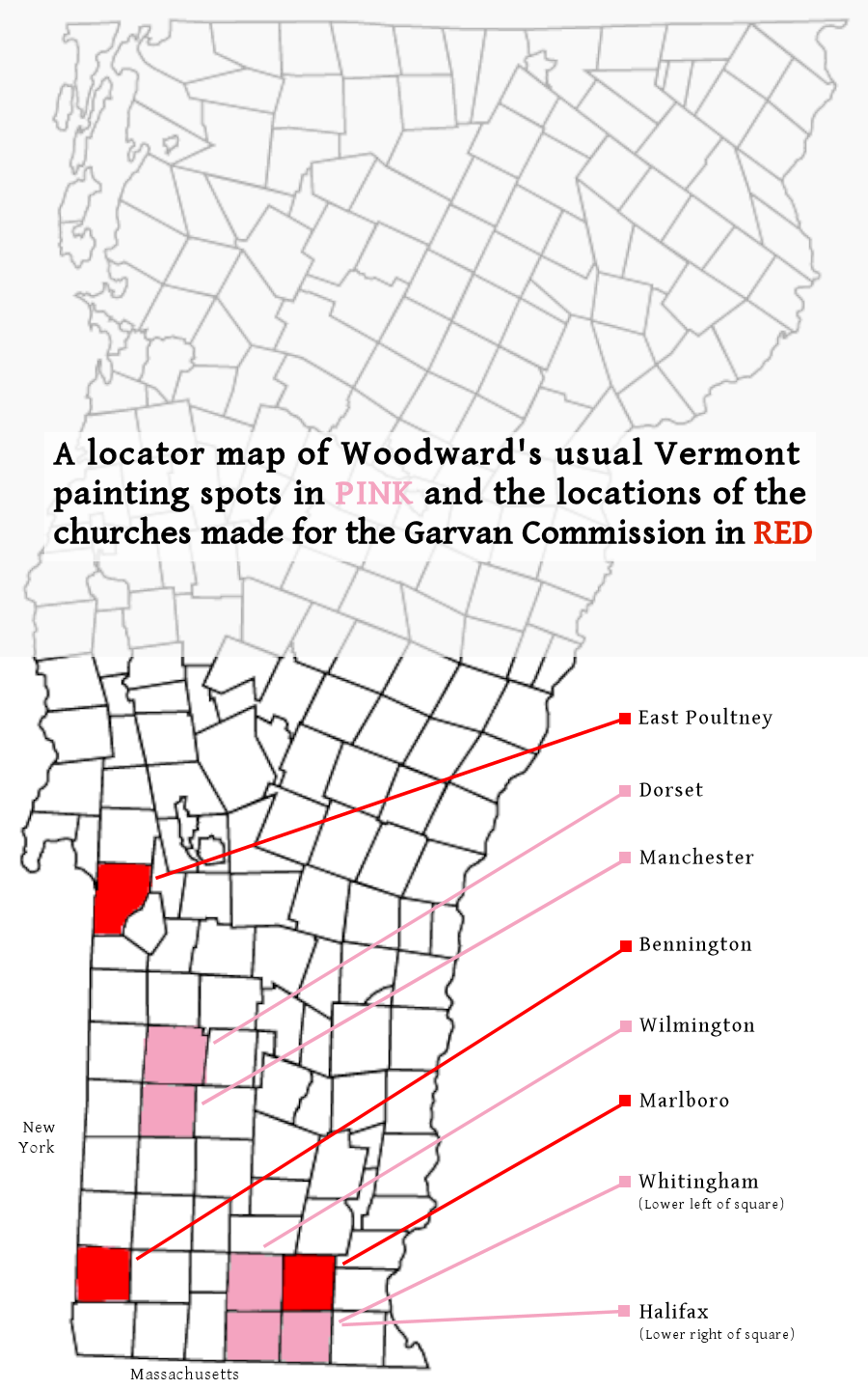
 A Vermont Town Map. We color the
A Vermont Town Map. We color the
Vermont towns Woodward frequents through
his career in pink. In red are the towns he
paints his church paintings for the study.
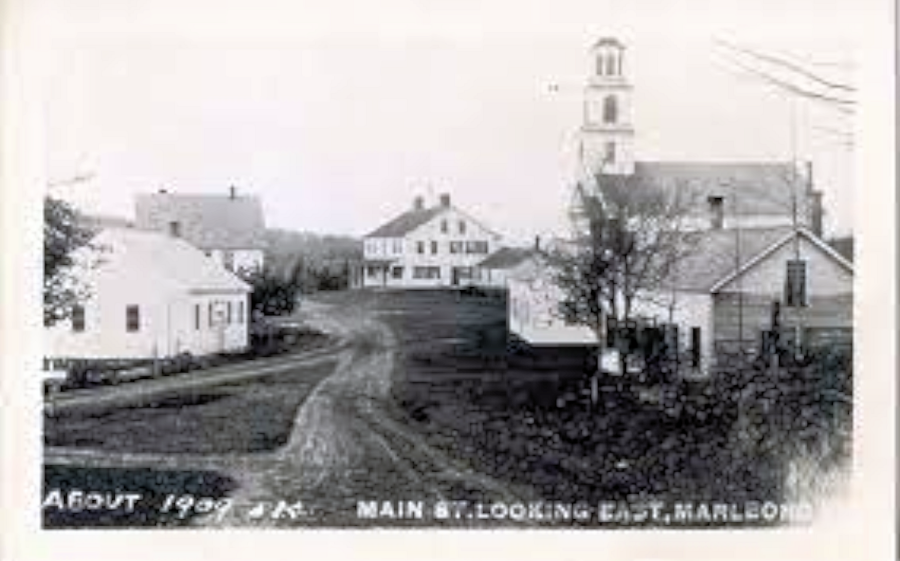
 A photograph of Main Street looking east,
A photograph of Main Street looking east,
Marlboro, VT in or about 1909. Note the dirt road.
Going with the assumption that Woodward went to Marlboro to paint this scene. We learn from his diary entry for, New England (1940- also not part of the commission), he calls the scene, "a typical New England village street." This is important because while the painting became about the church, it was not necessarily a church-scene he was painting. More on this later in the essay, but for now the distinction is significant to the story.
For additional context, Enduring New England is a depression-era painting when Woodward leaves the pure landscapes of nature to produce a series of typical New England scenes of farms, homes, roads and villages. He has just won one of only four Gold Medal honors at Boston's Tercentennial Celebration Exhibition in Boston for New England Drama (the only landscape artist honored). It is safe for us to say, for now, that the appeal of the scene is more about the village center and its dirt road than it is about the church.
What changes this is that the 1776 church would burn the next year in 1931. That very same year, Enduring New England first exhibits at the Grand Central Art Galleries in NYC where it is seen by the architect hired to re-build the new church and he will use the painting to help recreate its design. The painting now becomes about the church, although an argument can be made that is most likely the weather-worn home to the right of it linked by the road to the farmer in the field and farmhouse in the distance that appealed most to Woodward. We will make that argument after we introduce Mr. Garvan and when we illustrate how the paintings changed and what inevitably happened to them.
CLICK HERE for more on the Lyman Residence Exhibition
( Page will open in a new tab)
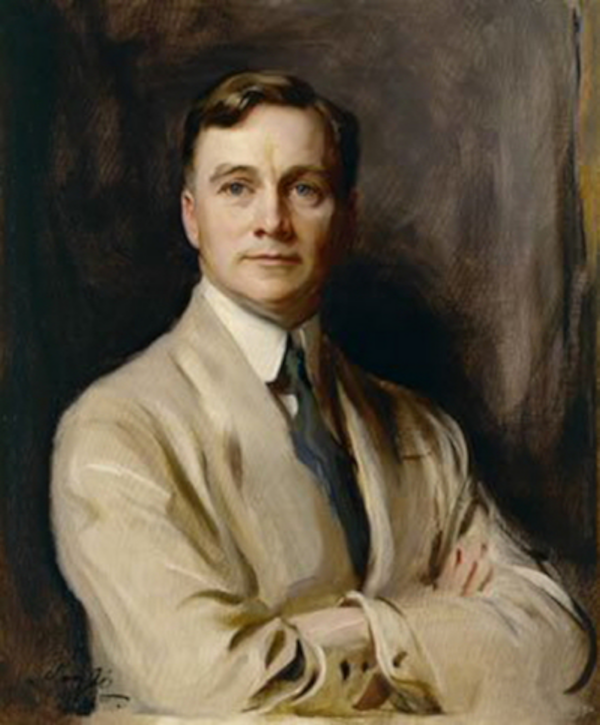
 Francis Garvan (1875 -1937) portrait
Francis Garvan (1875 -1937) portrait
Lawyer, Philanthropist, and along with his wife,
Mabel Brady, collectors of Early American furni-
ture, decorative art, crafts, and silverware.
THE CONNECTION: Network or Happenstance
As far as we know, Mr. Garvan nor his wife, have not bought any paintings from Woodward outside of Enduring New England and so it is fair to say there was not relationship prior to the agreement on the commission project. With that being said, it raises the questions, (1) where did the idea originate? (2) who originated it? and (3) how was Woodward chosen?
The Garvans were generous supporters of the arts and like many of their status had their hands in a variety of different things. It is possible that Garvan heard of Woodward's work when he came across the architect in charge of the rebuilding of the Marlboro Church and a New York City resident. Mr. Garvan is a lawyer and once an assistant district attorny for NYC. However, he is primarily known for being the head of the Chemical Foundation Inc. A semi-official agency of the government that dealt with the despencing and licensing of patents seized from Germany after World War 1. This is a possible link to a close Woodward friend and customer, Emmett Naylor, who was also a trade association administrator and lawyer. Naylor could very well have had a relationship with Mr. Garvan regarding the chemical licensing business. But we feel it is far more likely the person that brought Woodward and Garvan together was Mrs. Ada Small Moore.
Mrs. Ada Moore married Judge Wm. Henry Moore, a law partner at her father's Chicago law firm, Edward Alonzo Small. Judge Moore left Chicago to work for financier J.P. Morgan and then went on to carve his own niche in industry and finance. His occupation as a lawyer and his status in New York City's society would have certaintly put the Moores in the same circles as the Garvans. But it is there mutual link to Yale University that makes Mrs. Moore the most likely connection between Mr. Garvan and Woodward.
Mr. Moore's father, Nathaniel Ford Moore, a mid-eighteenth century graduation of Yale, was also an original member of the Yale Corporation (officially The President and Fellows of Yale College, and is the governing body of Yale University). Mr. Garvan, a graduate of Yale was very devoted to his alma mater. Judge Moore died fairly young in 1928. It is rumored that he was never in good health, leaving Mrs. Moore one of the wealthiest widows in the country. But Ada was as equally strong-willed as her husband and was very active in her philanthropy. Her focus was on supporting archeological endeavors and even participating in the digs herself. She traveled the world collecting artifacts and antiquties from the Middle and Far East. Her collection, as was the Garvans, was intended for and eventually given to Yale for their permanant collections.


####


#####


#####

 ####
####
HAPPILY MARRIED: The Vose Gallery
Lorem ipsum dolor sit amet, consectetur adipiscing elit. Curabitur egestas nibh ut purus posuere, vitae fringilla orci dignissim. Etiam tincidunt odio ut ante vestibulum hendrerit. Donec a justo risus. Duis eget congue arcu. Aliquam congue scelerisque diam eu lobortis. Quisque non nunc quis dui pellentesque lacinia sed et nibh. In vitae varius erat. In congue dapibus rhoncus. Ut eget semper quam, vel viverra metus. Suspendisse euismod leo non sagittis sagittis. Ut faucibus, quam ac malesuada posuere, felis erat tristique sapien, sed scelerisque neque ipsum et velit. Aliquam in libero erat. Mauris iaculis ante a velit rhoncus feugiat. Vivamus faucibus non justo vel iaculis.

 ###
###
Proin sollicitudin eget erat vel varius. Suspendisse sit amet mi vestibulum, malesuada neque sed, eleifend magna. Etiam quis dolor quis mi condimentum pulvinar quis fringilla arcu. Aenean id ornare velit. Sed eget varius purus. Suspendisse hendrerit pharetra tempus. Suspendisse potenti. Nunc neque odio, malesuada id maximus ut, cursus at lectus. Integer ac hendrerit ante. Duis ut urna in velit elementum rutrum sit amet at tellus. Mauris consequat, tellus sit amet pulvinar hendrerit.
Vestibulum dapibus, ante quis imperdiet tristique, massa magna finibus magna, ac iaculis sapien erat sed tellus. In varius sollicitudin nulla ac ullamcorper. Duis ut mattis ante. Aenean viverra sed ipsum et pharetra. In fringilla nisi at commodo condimentum. Integer scelerisque nec nisl malesuada tincidunt. Nunc bibendum fermentum mauris, non semper justo vehicula ut. Suspendisse sagittis tellus eget faucibus hendrerit. Phasellus eleifend faucibus libero id mollis. Nulla non dui id lectus sagittis rutrum. Donec mollis erat nec erat tempus molestie. Sed tincidunt ultrices dui, at rutrum lorem gravida fringilla. Nulla eget ex libero. Fusce malesuada turpis hendrerit viverra varius.
Donec turpis urna, consequat eget accumsan id, tincidunt in sapien. Aliquam imperdiet risus in tortor suscipit, sed malesuada ligula consequat. Nam feugiat viverra quam id sagittis. Curabitur egestas vel metus ornare fermentum. Phasellus mattis, nulla vitae condimentum fermentum, nisi diam dapibus nunc, at consectetur est felis posuere eros. Suspendisse potenti. Vestibulum sollicitudin mollis ipsum, vitae egestas nisl tempus sed. Proin vel nulla leo. Morbi fringilla porta dui eu scelerisque. Nunc non lobortis nulla.

